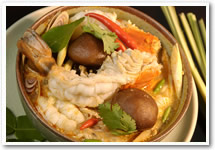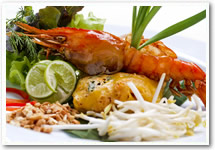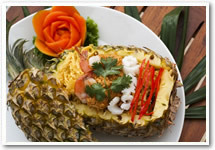Thai Food and Fruits
Thai Food and Fruits
วันที่นำเข้าข้อมูล 17 Feb 2016
วันที่ปรับปรุงข้อมูล 27 Nov 2022
Introduction
Thai food is internationally famous. Whether chilli-hot or comparatively blands, harmony is the guiding principle behind each dish. Thai cuisine is essentially a marriage of centuries-old Eastern and Western influences harmoniously combined into something uniquely Thai. The characteristics of Thai food.
Depend on who cooks it, for whom it is cooked, for what occasion, and where it is cooked to suit all palates. Originally, Thai cooking reflected the characteristics of a waterborne lifestyle. Aquatic animals, plants and herbs were major ingredients. Large chunks of meat were eschewed. Subsequent influences introduced the use of sizeable chunks to Thai cooking.
With their Buddhist background, Thais shunned the use of large animals in big chunks. Big cuts of meat were shredded and laced with herbs and spices. Traditional Thai cooking methods were stewing and baking, or grilling. Chinese influences saw the introduction of frying, stir frying and deep-frying. Culinary influences from the 17th century onwards included Portuguese, Dutch, French and Japanese. Chillies were introduced to Thai cooking during the late 1600s by Portuguese missionaries who had acquired a taste for them while serving in South America.
Thais were very adapt at 'Siamese-icing' foreign cooking methods, and substituting ingredients. The ghee used in Indian cooking was replaced by coconut oil, and coconut milk substituted for other daily products. Overpowering pure spices were toned down and enhanced by fresh herbs such as lemon grass and galanga. Eventually, fewer and less spices were used in Thai curries, while the use of fresh herbs increased. It is generally acknowledged that Thai curries burn intensely, but briefly, whereas other curries, with strong spices, burn for longer periods. Instead of serving dishes in courses, a Thai meal is served all at once, permitting dinners to enjoy complementary combinations of different tastes.
A proper Thai meal should consist of a soup, a curry dish with condiments, a dip with accompanying fish and vegetables. A spiced salad may replace the curry dish. The soup can also be spicy, but the curry should be replaced by non spiced items. There must be a harmony of tastes and textures within individual dishes and the entire meal.
Eating & Ordering Thai Food
Thai food is eaten with a fork and spoon. Even single dish meals such as fried rice with pork, or steamed rice topped with roasted duck, are served in bite-sized slices or chunks obviating the need for a knife. The spoon is used to convey food to the mouth. Ideally, eating Thai food is a communal affair involving two or more people, principally because the greater the number of diners the greater the number of dishes ordered. Generally speaking, two diners order three dishes in addition to their own individual plates of steamed rice. Three diners four dishes, and so on.
Diners choose whatever they require from shared dishes and generally add it to their own rice. Soups are enjoyed concurrently with rice. Soups are enjoyed concurrently with other dishes, not independently. Spicy dishes, not independently. Spicy dishes are "balanced" by bland dishes to avoid discomfort.
The ideal Thai meal is a harmonious blend of the spicy, the subtle, the sweet and sour, and is meant to be equally satisfying to eye, nose and palate. A typical meal might include a clear soup (perhaps bitter melons stuffed with minced pork), a steamed dish (mussels in curry sauce), a fried dish (fish with ginger), a hot salad (beef slices on a bed of lettuce, onions, chillies, mint and lemon juice) and a variety of sauces into which food is dipped. This would be followed by sweet desserts or fresh fruits such as mangoes, durian, jackfruit, papaya, grapes or melon.
What Comprises a Thai Meal
| Titbits | |
|---|---|
 |
These can be hors d'oeuvres, accompaniments, side dishes, and/or snacks. They include spring rolls, satay, puffed rice cakes with herbed topping. They represent the playful and creative nature of the Thais. |
| Salads | |
 |
A harmony of tastes and herbal flavours are essential. Major tastes are sour, sweet and salty. Spiciness comes in different degrees according to meat textures and occasions. |
| Dips | |
 |
Dips entail some complexity. They can be the major dish of a meal with accompaniments of vegetables and some meats. When dips are made thinly, they can be used as salad designs. A particular and simple dip is made from chilies, garlic, dried shrimps, lime juice, fish sauce, sugar and shrimp paste. |
| Soups | |
 |
A good meal for an average person may consist simply of a soup and rice. Traditional Thai soups are unique because they embody more flavours and textures than can be found in other types of food. |
| Curries | |
 |
Most non-Thai curries consist of powdered or ground dried spices, whereas the major ingredients of Thai curry are fresh herbs. A simple Thai curry paste consists of dried chilies, shallots and shrimp paste. More complex curries include garlic, galangal, coriander roots, lemon grass, kefir lime peel and peppercorns. |
| Single Dishes | |
 |
Complete meals in themselves , they include rice and noodle dishes such as Khao Phat and Phat Thai. |
| Desserts | |
 |
No good meal is complete without a Thai dessert. Uniformly sweet, they are particularly welcome after a strongly spiced and herbed meal. |
Preparing Thai Food
| Titbits | |
|---|---|
| A simple kind of titbit is fun to make. You need shallots, ginger, lemon or lime, lemon grass, roasted peanuts and red phrik khi nu chilies. Peeled shallots and ginger should be cut into small fingertip sizes. Diced lime and slices of lemon grass should be cut to the same size. Roasted peanut should be left in halves. Chilies should be thinly sliced. Combinations of such ingredients should be wrapped in fresh lettuce leaves and laced with a sweet-salty sauce made from fish sauce, sugar, dried shrimps and lime juice. |
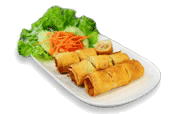 |
| Dips | |
| Mixing crushed fresh chilies with fish sauce and a dash of lime juice makes a general accompanying sauce for any Thai dish. Adding some crushed garlic and a tiny amount of roasted or raw shrimp paste transforms it into an all-purpose dip (nam phrik). Some pulverized dried shrimp and julienned egg-plant with sugar makes this dip more complete. Serve it with steamed rice, an omelets and some vegetables. |
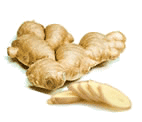 |
| Salad Dressings | |
| Salad dressings have similar base ingredients. Add fish sauce, lime juice and sugar to enhance saltiness, sourness and sweetness. Crushed chilies, garlic and shallots add spiciness and herbal fragrance. Lemon grass and galangal can be added for additional flavour. Employ this mix with any boiled, grilled or fried meat. Lettuce leaves, sliced cucumber, cut spring onions and coriander leaves help top off a salad dressing. |
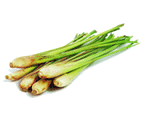 |
| Soup Stocks | |
| Soups generally need good stock. Add to boiling water crushed peppercorns, salt, garlic, shallots, coriander roots, and the meats or cuts of one's choice. After prolonged boiling and simmering , you have the basic stock of common Thai soups. Additional galangal, lemon grass, kefir lime leaves, crushed fresh chilies, fish sauce and lime juice create the basic stock for a Tom Yam. |
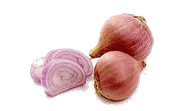 |
| Curries | |
| To make a quick curry, fry curry or chili paste in heated oil or thick coconut milk. Stir and fry until the paste is well cooked and add meats of one's choice. Season with fish sauce or sugar to taste. Add water or thin coconut milk to make curry go a longer way. Add sliced eggplant with a garnish of basil and kefir lime leaves. Make your own curry paste by blending fresh (preferably dried) chilies, garlic, shallots, galangal, lemon grass, coriander roots, ground pepper, kefir lime peels and shrimp paste. |
 |
| Single Dish Meals | |
| Heat the cooking oil, fry in a mixture of crushed chilies, minced garlic, ground pepper and chopped chicken meat. When nearly cooked, add vegetables such as cut beans or eggplants. Season with fish sauce and garnish with kefir lime leaves, basil or balsam leaves. Cooked rice or fresh noodles added to the frying would make this a substantial meal. |
 |
________________________________________________
Text and pictures from http://www.sawadee.com/thailand/food/
สถานเอกอัครราชทูต ณ กรุงโคเปนเฮเกน
Office Hours: Monday - Friday, 09:00 - 11:45 hrs. and 13:00 - 15:45 hrs. (Except public holidays)
